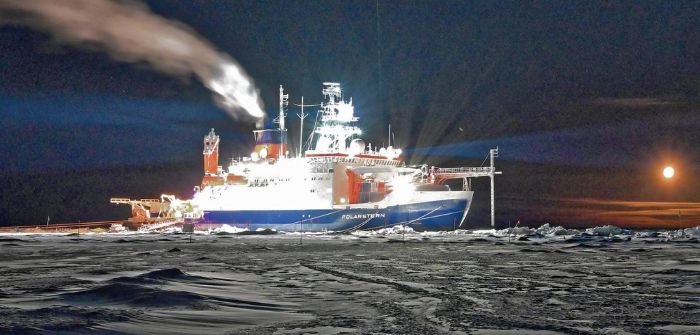For the first time during the MOSAiC expedition, a multi-wavelength lidar provides data on fine dust in the central Arctic during polar night
The atmosphere of the central Arctic is polluted with fine dust from Siberia and North America. This was the result of a preliminary evaluation of the first lidar measurements carried out by the Leibniz Institute for Tropospheric Research (TROPOS) during the one-year MOSAiC expedition on board the RV Polarstern. For the first time, a multi-wavelength lidar was used during polar night in the central Arctic, which can measure dust particles at altitudes of up to 14km with laser pulses from the ground.
First data show several layers of dust from human sources and forest fires at altitudes of 5km, 6km and 12km. The data is an indication that the upper atmosphere of the region around the North Pole is more polluted in winter than previously assumed. In the coming months, the international MOSAiC expedition led by the Alfred Wegener Institute, Helmholtz Centre for Polar and Marine Research (AWI), will provide data on climate change in the central Arctic, for which almost no measurements are available due to the extreme conditions of polar night.
On October 4, the research vessel Polarstern reached the ice floe at 85° north and 137° east with which the icebreaker and an extensive measuring network on the ice intend to drift through the central Arctic at the North Pole for a year. With the official start of the MOSAiC expedition, the OCEANET container on board Polarstern also began its work.
“Together with the containers of our US and Swiss partners, our container is located on the foredeck of RV Polarstern. I was able to put our laser into operation immediately after the end of the loading work. The aim is to measure the suspended particles in the atmosphere above the ship around the clock for a year,” reports Dr Ronny Engelmann of TROPOS, who is in charge of the measurements on board during the first leg of the voyage until he is replaced at the end of December 2019.
Atmospheric research is thus breaking new ground. “The operation of our laser-based remote sensing system PollyXT in the central Arctic is unique to date. Never before the atmosphere in this remote region has been studied with a multi-wavelength lidar that works with light of different wavelengths from ultraviolet to infrared. Only with this combination is it possible to determine different suspended particles that can originate from various sources such as forest fires, volcanic ash, anthropogenic air pollution or the sea surface,” explains Dr Albert Ansmann, head of the ground-based remote sensing group at TROPOS.
For more than 20 years, TROPOS has been developing and operating lidar devices to investigate the properties of suspended particles, known as aerosols. These devices scan the atmosphere above the ground like a light radar with laser light and are therefore called lidars. Depending on the surface and shape of the particles, the laser light is reflected differently. If not only the transit time and quantity of the reflected light are measured but also its polarization, then conclusions can be drawn about the properties of the particles.
The team on RV Polarstern uses the latest generation of the mobile lidar system PollyXT, which emits laser pulses of ultraviolet (355nm wavelength), green (532nm wavelength) and infrared (1,064nm wavelength) light. It is received on 13 channels and thus covers a broad spectrum of light up to the infrared range.
Since the ground-level air layers in the Arctic are particularly important for atmospheric research, it was equipped with a near-field channel to collect data from 50m above the ship to altitudes of 35km. In addition, it measures with two fields of view in order to better detect the scattering of light in clouds. This dual-field-of-view technology, developed by TROPOS together with the National Academy of Sciences of Belarus, allows the determination of the size and number of cloud drops – an important parameter for climate models.
Worldwide there are currently only two devices of this type. “The other device is located in our LACROS container in Punta Arenas, Chile, where we are studying the atmosphere near Antarctica at the southern tip of South America together with the Magellan University (UMAG) and the University of Leipzig in the DACAPO-PESO measurement campaign. Due to the identical structure, the data from both polar regions can be easily compared. We are looking forward to the results,” says Ansmann.
MOSAiC stands for Multidisciplinary drifting Observatory for the Study of Arctic Climate. The MOSAiC expedition led by the Alfred Wegener Institute, Helmholtz Centre for Polar and Marine Research (AWI), is associated with unprecedented challenges. MOSAiC has a budget of around €140m (US$155m).
In the course of the year, approximately 300 scientists from 20 countries will be on board. Together, they want to explore the entire climate system in the central Arctic for the first time. They will collect data in the five sub-areas of atmosphere, sea ice, ocean, ecosystem and biogeochemistry to understand the interactions that shape the Arctic climate and life in the Arctic Ocean.
Further information on the expedition can be found at: www.mosaic-expedition.org.



